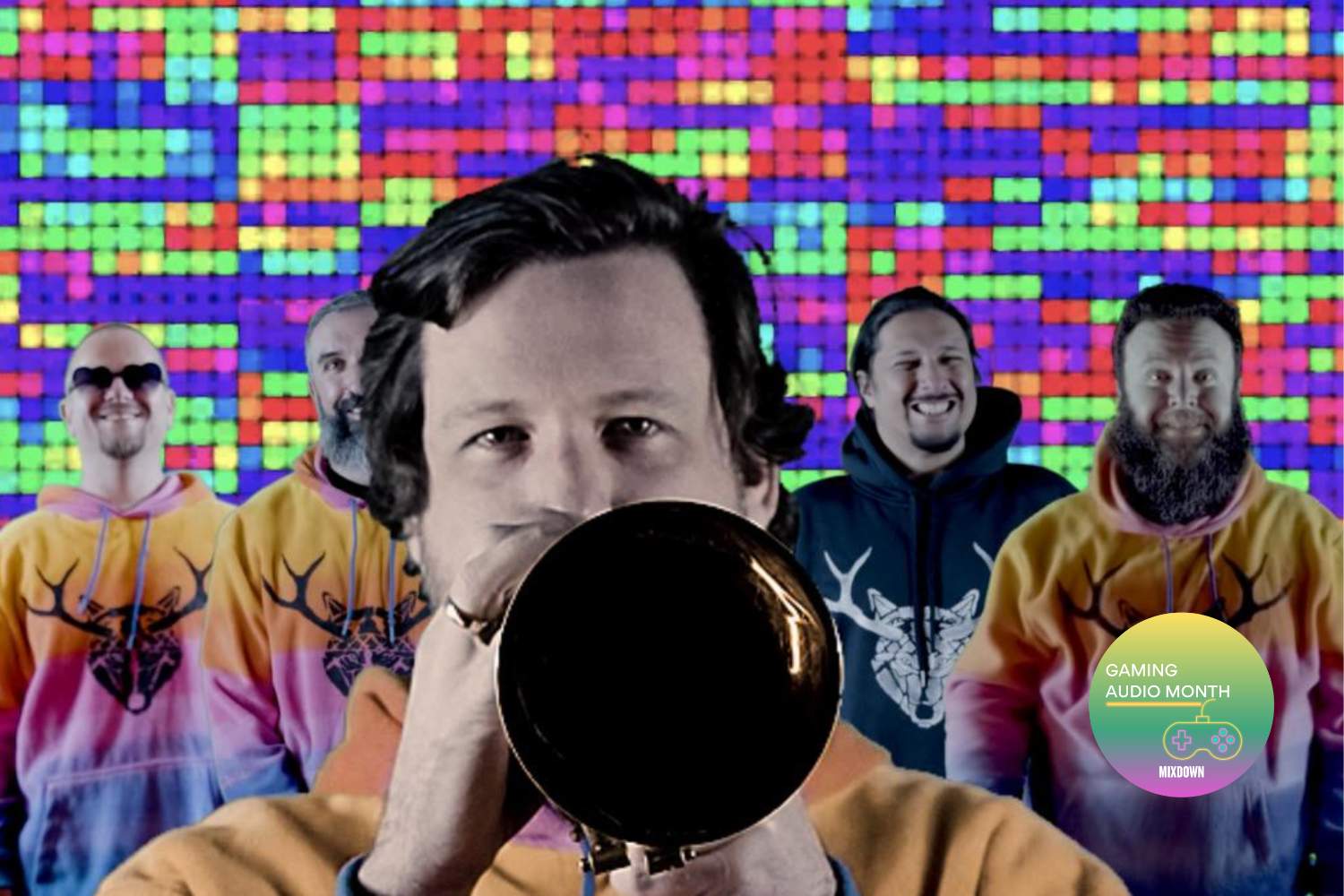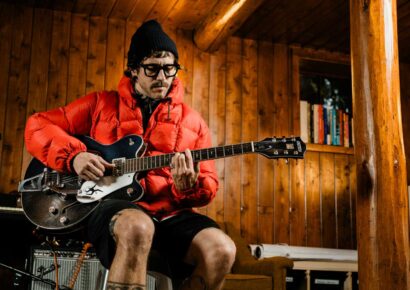GODSWOUNDS sat down with Mixy to chat about their diverse, trans-medial inspirations, as well as their innovative use of the Nintendo Gameboy as a fully fledged synthesizer!
Eora/Sydney based experimental-rock band GODSWOUNDS have returned with their boundary-pushing new track ‘Tantamount Love’ – produced and mixed by Toshi Kasai (Melvins, Tool).
Read up on all the latest interviews, features and columns here.
Accompanying the release is a music video that was filmed, directed, and edited by band’s frontman Lachlan Kerr, who taught himself animation from scratch to create it. The video is a vivid and psychedelic animation that time-lapses through the history of the Mongolian Empire until modern day. Bursting with vibrant colours and intricate visuals, it seamlessly weaves an amalgamation of history and contemporary life, where the band members become epic characters journeying through pivotal moments of history.
GODSWOUNDS
In celebration of the release, the band sat down with Mixy to chat about their diverse, trans-medial inspirations, as well as their innovative use of the Nintendo Gameboy as a fully fledged synthesizer!
Hi folks! To start out, I’d love to ask you about your lifelong musical background/s. What would you say are the key influences throughout your journey thus far that have led to the development of your genre-transcendent, richly layered sound?
As a kid, I was exposed to several artists that I’m obsessed with to this very day: Wendy Carlos, the Beach Boys and, of course, the mighty Queen.
Gameboy
At the same time, I played a lot of old NES and Gameboy games. As I got older, I got into weirder and more experimental music like Mr. Bungle, Zorn, heavier music like Burzum and AxCx and popular alternative fare like Cake, Nine Inch Nails, Ben Folds Five,
Faith No More, Pixies and, of course, Regurgitator.
As I finished uni, I began playing in bands in Sydney that were part of the Hip Hop and Post Rock scenes. Then, in about 2008-2009, I came back from a trip to Japan and decided to put together a band that sounded like what I had playing on loop in my head.
I think the amalgamation of all these factors led me to pursue the ‘Godswounds Sound’. Not to mention the fact Danny from Mr. Bungle actually ended up in the band!
Being a publication of the (extremely) gear-nerdy variety, we love seeing uses of tech that are entirely new to us, and were immediately captivated by the use of gaming technology in your most recent release. Where did the idea to connect a Gameboy’s soundcard to midi first spawn from? Can you break down just how you do this for us, technically?
Sure! So glad to be in the company of fellow nerds. The technology to access the sound card of Gameboys has actually been around for quite some time. There are some great software programs in cartridge form that allow you to sequence music with them. This basically spawned the whole chiptune scene.
I have a great deal of respect for those guys but it’s not really my thing. Coming from a piano/keyboard player background, I wanted to play the Gameboy like an instrument rather than use it to program music. I quite like ‘Muddy Jammer’ but it’s the genius of Catskull Electronics’ midi-to-Gameboy interface that has turned my Gameboy into a complete performance instrument, hooking it up to my old Edirol PCR800 Midi controller.
View this post on Instagram
Often those unacquainted can be somewhat ignorant of the true artistry and rich history that gaming sound design and composition comprises. Do you folks come from a gaming background?
Can you speak a little bit to your melding of these two disparate yet related media forms?
I most definitely come from a gaming background, as does Simeon (Bass), Shane (Drums) and Paul (Trumpet).
Obviously, the early composers of the 8bit/16bit era are the best in my opinion. Working with extreme tonal and polyphonic restraints but still creating fantastically emotive, catchy music.
8-bit audio
Everyone knows Koji Kondo (the Mario guy) but I was equally impressed by Hirokazu Tanaka from Kid Icarus, Jun Funahashi from the original Ninja Turtles game, Kazuo Sawa from River City Ransom and Kanzunaka Yamane from Double Dragon 2. There are countless amazing composers from this era, often writing striking contrapuntal melodies that create a sense of harmonic density far beyond the limitations of the technology they’re using.
This is in fact a key part of creator of the Gameboy, Gunpei Yokoi’s philosophy: “Lateral Thinking of Withered Technology” – getting the most out of the least, essentially. In my opinion, this is at the centre of everything we make with Godswounds.
Not just technologically, compositionally and tonally but also philosophically we celebrate this particular era of video games in our sound and attitude.
Could you tell me about your songwriting process – is it a collaborative affair, do members tend to tinker alone and then build from those skeletons, or is it a combination of both?
Essentially, I bash out a score in Sibelius, the guys sigh, roll their eyes, guffaw and then bring it to life, eyebrows and all, with their matchless talent.
Talk me through your recording workflow from demo to track completion. Do you begin in the bedroom or head straight to the studio? Any preference of DAW/special demo set up that goes the extra mile?
This time, I put some demos together at home for reference for Toshi and the band.
Traditionally, I’ve just sent them crappy midi tracks which, I found out, is actually everyone’s preference! As someone with a severe case of synthesis, Logic is my go-to DAW though I used Pro Tools a little this time to make life easier for Toshi.
Which pieces of equipment are the most integral to you when it comes to translating the project’s essence from a recorded to a live context? Are you trying to replicate your studio sound when you perform, or do you prefer to let the songs breathe and find their own live groove?
What an amazing question. Thank you so much for it.
I thought about dragging out a bunch of synths (Gameboy included) to play live but, frankly, it’s a very painful thing to do and I’m almost sure that something would stop working as soon as I needed it.
Raspberry Pi
Consequently, I use a nifty little workstation called the Squishbox. The Squishbox is a Raspberry Pi synth put together by the brilliant Dr. Bill Peterson of Geek Funk Labs. It runs soundfonts, meaning you can pretty much sample anything you want and play it as a sound live.
With a bit of head scratching and code typing, you can get the Squishbox to do everything you’d expect from a top of the line workstation, except it is much smaller, lighter and you are paying nowhere near as much money. Maybe like 10% of the cost, in fact.
Are there any pieces of gear you’ve acquired, be it something cheap that punches massively above its weight, or a less-wallet friendly splurge, that have tangibly influenced the way you write and record music to this day?
When I made this album I wanted something that created lush pads and ambient sounds with a video game flavour. Kasser’s DAFM synth features the YM2612 chip made famous by the Sega Genesis. It creates these beautiful FM tones but also features the crunchy “ladder” distortion the chip is infamous for, giving everything a lovely lo-fi edge.
What’s on the horizon? What exciting things can we expect from you for the remainder of the year?
Our new album comes out at the end of October which features quite a bit of Gameboy/DAFM playing as well as a bunch of other strange and exotic sounds.
We also have a gig in November to celebrate at Waywards in Newtown. Feel free to follow us on Facebook or Instagram and I’m sure we’ll tell you all about it.
Keep up to date with GODSWOUNDS here.

